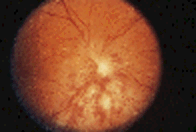FDA approves oral ganciclovir as CMV retinitis preventative
ROCHESTER, N.Y.—Treatment options for the most common ocular complication in AIDS patients, cytomegalovirus (CMV) retinitis, received a boost in December with Food and Drug Administration approval of ganciclovir capsules (Cytovene, Syntex) as the first preventive treatment for the sight-threatening disease.
How this approval will help optometrists manage CMV retinitis may depend in part on how complete a medical history they can elicit from patients, said Gabrielle Bodnar, MD, a retina specialist at Genesee Valley Eye Institute here.
Ganciclovir is currently used as maintenance therapy of CMV retinitis in people with AIDS; these patients are most susceptible to the disease when their CD4 counts fall below 100. When CMV invades the retina, lesions form, causing vision deterioration. If left untreated, CMV retinitis can lead to blindness.
Results published last month in the Archives of Ophthalmology indicate that a combination of ganciclovir and foscarnet (Foscavir, Astra Pharm) may offer patients with relapsing disease the most effective control ["Combination Foscarnet and Ganciclovir Therapy vs Monotherapy for the Treatment of Relapsed Cytomegalovirus in Patients with AIDS: The Cytomegalovirus Retreatment Trial." Arch Ophthalmol. 1996;114:23-32].
The trial, funded by the National Eye Institute, involved 279 patients who had been treated for CMV retinitis with either foscarnet or ganciclovir, but experienced a relapse. In patients who received both drugs, the CMV retinitis was controlled for approximately 4 months, while patients who were treated with either drug alone experienced a relapse in 1 to 2 months.
Necrosis a common symptom
Optometrists who diagnose CMV retinitis in patients with HIV should report the finding to the patient's HIV physician so treatment can begin immediately, said Bodnar, clinical assistant professor of ophthalmology at the University of Rochester School of Medicine and Dentistry.
If patients do not reveal their HIV status, but have the symptoms of CMV retinitis, Bodnar said it is reasonable to ask if there is anything in their medical history that could indicate the disease. "If the optometrist cannot elicit a history that suggests an infectious disease or of a specialist being involved, and believes that he or she is looking at CMV retinitis, the patient should be sent directly to a retina specialist," she said.
The symptoms of CMV retinitis in people with AIDS include flashes and floaters; visual field loss, specifically, loss of side vision; and smudged or cloudy vision. Upon examination, Bodnar said, "Optometrists might observe a lot of necrosis. The retina tends to look grayish and mothy and there may or may not be hemorrhages."
The symptoms are similar to those found in AIDS patients with ocular toxoplasmosis. However, the amount of inflammation seen in patients with toxoplasmosis is often greater than that seen with CMV infection. Patients with retinal detachment may also harbor CMV, and active CMV disease can often be found adjacent to the detachment.
Bodnar said other conditions that can masquerade as CMV retinitis include syphilis and other herpes family viruses such as herpes simplex and zoster.
The mainstay of treatment for patients with CMV retinitis is intravenous therapy, Bodnar said. Therapy may start with either foscarnet or ganciclovir twice daily for two to three weeks. Patients who respond favorably may be able to drop back to once-daily intravenous treatment, and also have the option of ganciclovir capsules for maintenance therapy.
Some practitioners opt for a ganciclovir implant as primary treatment for CMV retinitis, Bodnar said, for patients who cannot tolerate the drugs systemically, suffer from side effects or simply refuse intravenous therapy. The downside to an implant is that it is local therapy, she said, and in patients who present with bilateral disease, each eye needs individual treatment.
Prepare patients for recurrence
 --- Three delivery methods for treating CMV retinitis: Orally, intravenously or with the new implant.
--- Three delivery methods for treating CMV retinitis: Orally, intravenously or with the new implant.
According to Bodnar, one aspect of therapy optometrists should share with CMV retinitis patients includes preparing them for recurrences. "I tell patients it is not really a total failure or something unexpected," she said. "It is just the natural course of the disease in that we first get it under control and then it recurs eventually. The time between each subsequent recurrence is less and there are new medications available as investigational drugs on a compassionate basis for people who are breaking through everything else and still recurring."
Cidofovir (Vistide, Gilead Sciences) is one therapy available under an Investigational New Drug treatment program for patients with relapsing CMV retinitis. Candidates for this program are patients whose disease has progressed despite treatment with approved therapy, or who cannot tolerate such treatment.
Because CMV retinitis requires lifelong treatment, Bodnar believes the best manager of these patients is one consistent examiner.
"Once these patients are diagnosed with CMV retinitis, it helps to have one consistent observer to be able to tell when they are changing," she said.
"Many places take photos each visit, but in a clinic that cannot afford to do that, you have to do drawings, so it makes it critical that it is the same person. Someone else looking at my drawings is not going to know if something is advancing as easily as I would."
